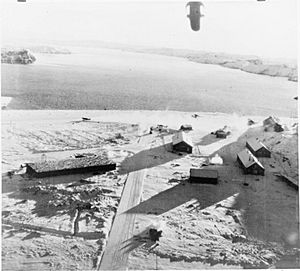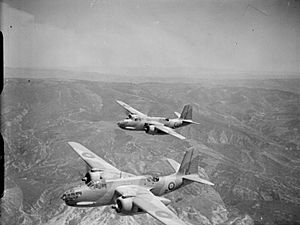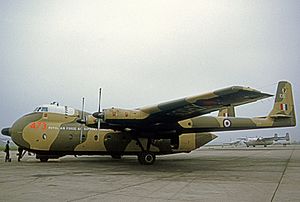No. 114 Squadron RAF facts for kids
Quick facts for kids No. 114 (Hong Kong) Squadron RAF |
|
|---|---|
| Active | 27 Sep 1917 - 1 Apr 1920 1 Dec 1936 – 1 Sep 1946 1 Aug 1947 – 31 Dec 1957 5 May 1959 – 29 Sep 1961 30 Sep 1961 – 31 Oct 1971 |
| Country | |
| Branch | |
| Nickname(s) | Hong Kong |
| Motto(s) | "With speed I strike" |
| Insignia | |
| Squadron Heraldry | A Cobra head |
| Squadron Codes | 114 (Mar 1937 - Apr 1939) FD (Apr 1939 - Sep 1939) RT Sep 1939 - Sep 1946) |
No. 114 Squadron was a special group of planes and pilots in the British Royal Air Force (RAF). It was first created in India during the First World War. This squadron flew as light bombers during the Second World War and later as transport planes after the war. It was officially stopped in 1971.
Contents
History of No. 114 Squadron
How the Squadron Started: World War I
No. 114 Squadron of the Royal Flying Corps began in September 1917. This happened in Lahore, India. It was formed by taking part of another group, No. 31 Squadron. On April 1, 1918, it became part of the new Royal Air Force.
The squadron used B.E.2 planes. They flew patrols over the North-West Frontier. Their main base was Quetta, with a smaller group in RAF Khormaksar, Aden. In October 1919, they started using some Bristol Fighters. However, the squadron was closed down on April 1, 1920. Its planes and people were then used to form No. 28 Squadron.
Reforming for World War II Missions

No. 114 Squadron started again on December 1, 1936. This happened at RAF Wyton in England. At first, they flew Hawker Hind biplanes, which were light bombers with one engine. On March 1, 1937, they joined No. 2 Group of RAF Bomber Command.
Later that month, they received newer planes called Bristol Blenheim Is. These were twin-engined planes. No. 114 Squadron was the very first RAF group to fly the Blenheim. They also used a few Hawker Audaxes for training. From April 1939, the squadron got improved Blenheim IVs. They practiced long-distance flights over France in July. In August 1939, they took part in a big air defense exercise.
Early War Operations and Challenges
The squadron flew its first missions of the Second World War on October 13, 1939. Two planes flew from France to scout over the Ruhr area in Germany. One of these Blenheims did not come back. The squadron was then sent to join the Advanced Air Striking Force (AASF). They moved to France in December 1939.
On May 10, 1940, Germany invaded Belgium and the Netherlands. The next day, German planes attacked 114 Squadron's airfield at Vraux. Six of their Blenheims were destroyed, and the rest were damaged. Even though the squadron flew some bombing missions against the German advance, they lost too many planes. They soon had to go back to the UK. Their remaining Blenheims helped other groups with scouting missions.
Attacks and Convoy Duties
The squadron rejoined 2 Group on June 10, 1940. They attacked groups of barges in German-controlled ports. They also bombed German airfields at night. In March 1941, the squadron helped RAF Coastal Command. They escorted convoys and patrolled the North Sea. They flew from RAF Thornaby and RAF Leuchars. In July 1941, they returned to Bomber Command at RAF West Raynham.
On August 12, 1941, the squadron took part in a big attack. Many 2 Group Blenheims flew low to attack two power stations. These were at Knapsack and Quadrath near Cologne. No. 114 Squadron sent 12 Blenheims to attack the Knapsack power station. They lost one plane to anti-aircraft fire. Overall, 12 Blenheims were lost out of 54 planes sent on this raid. The squadron also flew night attacks and bombing missions.
The Channel Dash and North Africa
On February 11, 1942, German battleships broke out from Brest, France. These ships were the Scharnhorst, Gneisenau, and the heavy cruiser Prinz Eugen. They sailed up the English Channel to return to Germany. British forces only saw them when they were near Dover. This led to British ships and planes trying to sink the German ships.
Nine of 114 Squadron's Blenheims were part of 242 Bomber Command planes sent. Three of the squadron's planes saw the German battleships and attacked. However, their bombs and torpedoes missed. The battleships were damaged by mines that had been laid earlier. The squadron continued night attacks through March and April 1942. On the night of May 30/31, they attacked German night-fighter bases. This was to support a huge RAF raid on Cologne.
In August 1942, the squadron stopped its night missions. They began to train with the newer Blenheim Mark V bomber. This plane was also called the Bisley. They were getting ready to support Operation Torch. This was the invasion of French North Africa by British and American forces.
The squadron moved to Blida in Algeria in November 1942. Their job was to support the British First Army. However, the Bisley plane did not perform well. It was easy for enemy fighters to attack. So, the squadron mostly flew night bombing missions. They kept losing many Bisleys. In January 1943, the squadron gave their Bisleys to 614 Squadron. They waited for new planes. They received more Bisleys in February and started missions again. In March, the squadron finally got better planes. They replaced their Bisleys with Douglas Boston light bombers. They started flying missions with their new planes on April 21.
The squadron then operated from Sicily and Italy. They continued to use Douglas Boston aircraft until the end of the war. After the war, they switched to the De Havilland Mosquito.
After the War: Transport Missions
The squadron started again in Egypt in 1947. They were based at RAF Kabrit. They used Dakota transport planes. Later, they flew Vickers Valettas and De Havilland Chipmunks.
The last plane the squadron used was the Armstrong Whitworth AW.660 Argosy. This was a tactical transport aircraft. They flew it from their base at RAF Benson from 1962 until 1971. In 1971, the squadron was finally closed down for good.
Aircraft Flown by No. 114 Squadron
| From | To | Aircraft | Variant |
|---|---|---|---|
| Sep 1917 | Oct 1919 | B.E.2 | |
| Oct 1919 | Apr 1920 | Bristol F2 | b |
| Sep 1936 | Feb 1937 | Hawker Hind | Mk.I |
| Mar 1937 | May 1939 | Bristol Blenheim | Mk.I |
| May 1939 | Mar 1943 | Bristol Blenheim | Mk.IV |
| Apr 1943 | Sep 1945 | Douglas Boston | |
| Sep 1945 | Sep 1946 | De Havilland Mosquito | |
| Apr 1947 | Aug 1949 | Douglas DC3 | Dakota |
| Apr 1947 | Dec 1957 | Vickers Valetta | C1 |
| Dec 1958 | Mar 1959 | De Havilland Chipmunk | T10 |
| May 1959 | Sep 1961 | Handley Page Hastings | |
| Oct 1961 | Oct 1971 | Armstrong Whitworth Argosy |



